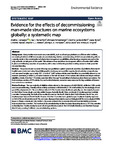Evidence for the effects of decommissioning man-made structures on marine ecosystems globally: a systematic map
| dc.contributor.author | Lemasson, Anaëlle | |
| dc.contributor.author | Somerfield, P | |
| dc.contributor.author | Schratzberger, M | |
| dc.contributor.author | McNeill, L | |
| dc.contributor.author | Nunes, J | |
| dc.contributor.author | Pascoe, C | |
| dc.contributor.author | Watson, S | |
| dc.contributor.author | Thompson, M | |
| dc.contributor.author | Couce, E | |
| dc.contributor.author | Knights, Antony | |
| dc.date.accessioned | 2022-11-11T15:07:57Z | |
| dc.date.issued | 2022-11-01 | |
| dc.identifier.issn | 2047-2382 | |
| dc.identifier.issn | 2047-2382 | |
| dc.identifier.other | 35 | |
| dc.identifier.uri | http://hdl.handle.net/10026.1/19958 | |
| dc.description.abstract |
Background: Many marine man-made structures (MMS), such as oil and gas platforms or offshore wind turbines, are nearing their ‘end-of-life’ and require decommissioning. Limited understanding of MMS decommissioning effects currently restricts the consideration of alternative management possibilities, often leaving complete removal as the only option in certain parts of the world. This evidence-base describes the ecosystem effects of marine MMS whilst in place and following cessation of operations, with a view to informing decision-making related to their potential decommissioning. Method: The protocol used to create this map was published a priori. Systematic searches of published, literature in English were conducted using three bibliographic databases, ten specialist organisational websites or repositories, and one search engine, up to early 2021. A total of 15,697 unique articles were identified as potentially relevant to our research questions, of which 2,230 were screened at the full-text level. Of that subset, 860 articles met all pre-defined eligibility criteria. A further 119 articles were identified through “snowballing” of references from literature reviews. The final database consists of 979 articles. For each article included, metadata were extracted for key variables of interest and coded into a database. Review findings: The vast majority of eligible articles related to the presence of MMS (96.2%), while just 5.8% considered decommissioning. Overall, articles mainly considered artificial reefs (51.5% of all articles) but increasingly oil and gas (22%), shipwrecks (15.1%) and offshore wind (13.1%). Studies were distributed globally, but the majority focused on the United States, single countries within Europe, Australia, Brazil, China, and Israel; 25 studies spanned multiple countries. Consequently, the bulk of the studies focused on the North Atlantic (incl. Gulf of Mexico, North Sea, and Mediterranean Sea) and North Pacific Oceans. A further 12 studies had a global scope. Studies in majority reported on fish (53%) and invertebrates (41%), and were disproportionately focused on biological (81%) and ecological (48%) impacts. Physico-chemical (13%), habitat (7%), socio-cultural (7%), economic (4%) and functional (8%) outcomes have received less attention. The number of decommissioning studies has been increasing since ca. 2012 but remains noticeably low. Studies mostly focus on oil and gas infrastructures in the USA (Gulf of Mexico) and Northern Europe (North Sea), covering 9 different decommissioning options. Conclusions: This systematic map, the first of its kind, reveals a substantial body of peer-reviewed evidence relating to the presence of MMS in the sea and their impacts, but with considerable bias toward biological and ecological outcomes over abiotic and socio-economic outcomes. The map reveals extremely limited direct evidence of decommissioning effects, likely driven at least in part by international policy preventing consideration of a range of decommissioning options beyond complete removal. Despite evidence of MMS impacts continuing to grow exponentially since the early 1970s, this map reveals key gaps in evidence to support best practice in developing decommissioning options that consider environmental, social and economic effects. Relevant evidence is required to generate greater understanding in those areas and ensure decommissioning options deliver optimal ecosystem outcomes. | |
| dc.format.extent | 35- | |
| dc.language | en | |
| dc.language.iso | en | |
| dc.publisher | BioMed Central | |
| dc.subject | Oil and gas | |
| dc.subject | Offshore wind | |
| dc.subject | Marine renewable energy | |
| dc.subject | Artificial reefs | |
| dc.subject | North sea | |
| dc.subject | Synthesis | |
| dc.subject | Repurposing | |
| dc.subject | Reefing | |
| dc.title | Evidence for the effects of decommissioning man-made structures on marine ecosystems globally: a systematic map | |
| dc.type | journal-article | |
| dc.type | Journal Article | |
| plymouth.author-url | https://www.webofscience.com/api/gateway?GWVersion=2&SrcApp=PARTNER_APP&SrcAuth=LinksAMR&KeyUT=WOS:000877012600001&DestLinkType=FullRecord&DestApp=ALL_WOS&UsrCustomerID=11bb513d99f797142bcfeffcc58ea008 | |
| plymouth.issue | 1 | |
| plymouth.volume | 11 | |
| plymouth.publication-status | Published online | |
| plymouth.journal | Environmental Evidence | |
| dc.identifier.doi | 10.1186/s13750-022-00285-9 | |
| plymouth.organisational-group | /Plymouth | |
| plymouth.organisational-group | /Plymouth/Faculty of Science and Engineering | |
| plymouth.organisational-group | /Plymouth/Faculty of Science and Engineering/School of Biological and Marine Sciences | |
| plymouth.organisational-group | /Plymouth/REF 2021 Researchers by UoA | |
| plymouth.organisational-group | /Plymouth/REF 2021 Researchers by UoA/UoA07 Earth Systems and Environmental Sciences | |
| plymouth.organisational-group | /Plymouth/Users by role | |
| plymouth.organisational-group | /Plymouth/Users by role/Academics | |
| plymouth.organisational-group | /Plymouth/Users by role/Researchers in ResearchFish submission | |
| dcterms.dateAccepted | 2022-09-20 | |
| dc.rights.embargodate | 2022-11-12 | |
| dc.identifier.eissn | 2047-2382 | |
| dc.rights.embargoperiod | Not known | |
| rioxxterms.versionofrecord | 10.1186/s13750-022-00285-9 | |
| rioxxterms.licenseref.uri | http://www.rioxx.net/licenses/all-rights-reserved | |
| rioxxterms.type | Journal Article/Review | |
| plymouth.funder | Decommissioning – Relative effects of alternative management strategies::UKRI; NERC |


